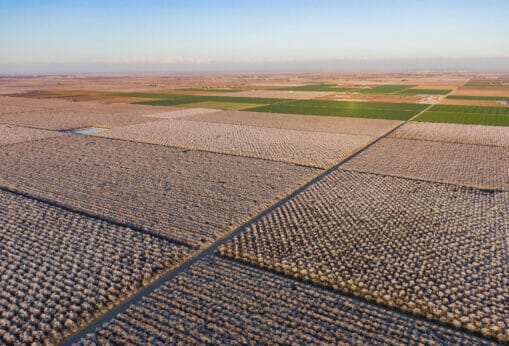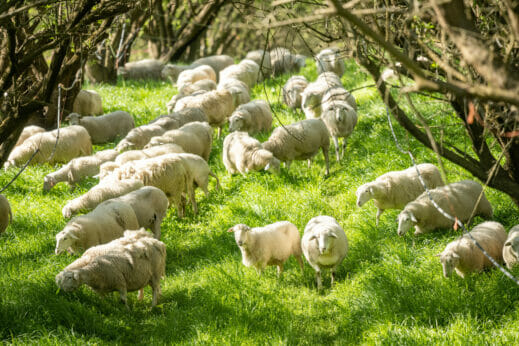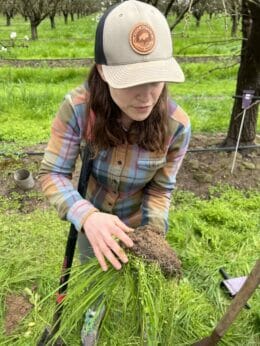Rising temperatures, lack of water and encroaching development are creating tough conditions for the crucial California crop. Their continued viability could all depend on strengthening the lands on which they sit.

As Brian Paddock walks through his 12-and-a-half acres of almond trees, he’s taking in everything. Paddock, like a lot of farmers, is a details guy. He pays attention to each tree, to the soil surrounding it, to the temperature and the wind speed.
But Paddock pays especially close attention to water usage, as much for environmental reasons as economic ones. For instance, he knows that he uses 0.87 gallons of water to grow one individual almond. “Every gallon I pump, it’s like running a taxicab meter that just keeps chipping away.”
He’s tinkered with different irrigation systems, moving from a sub-surface drip setup to his current above-ground micro-sprayer, which he says has the best distribution of water with the least waste. For Paddock, maximizing “crop per drop”—getting the most yield with the least amount of water—is important.
It’a not just because it’s cheaper and not just because Capay Hills Orchard, his farm just north of Sacramento, is in an area of California that is increasingly drought-prone. It’s also because he’s on a mission to prove that almonds are a viable crop, now and into the future.
Almonds are notorious for being a thirsty crop. It’s a reputation that Paddock and other growers say isn’t deserved, but the idea has circulated for years just the same. The Atlantic took aim at almonds in 2014. Mother Jones put out a series of now legendary (within the almond industry, at least) stories around the same time. Forbes wrote about them last year. The New York Times has run op-eds on almonds, along with the Los Angeles Times.
The thing is, those reports are correct. The “water footprint” of one almond—how much water it takes to grow a single nut—is generally anywhere from one to three gallons, if you include rainwater (Paddock is proud to point out that he sits below average when it comes to water use). That’s hard to ignore. It’s similar for pistachios, which use a little under a gallon, and even worse for walnuts, which clock in at close to five gallons per nut. Almonds use a lot of water, but just how much of the state’s precious resource they use is contested. The Almond Board of California has said the nuts use nine percent of the state’s agricultural water. The nonprofit California Water Impact Network says that figure is actually closer to 17 percent.
It’s also true that California farmers need to increasingly rely on groundwater from wells during periods of drought, when there’s not enough rain or surface water at their disposal. As the Forbes article points out, thousands of wells across California have dried up in the past decade.
With the majority of all almonds grown in California, there are increasingly uncomfortable questions for the drought-prone state. California is responsible for 80 percent of the world’s almonds, and they bring billions of dollars into the state. They are the biggest agricultural export in the state by far. But if California has limited water, why keep growing almonds? Is it sustainable? Is it ethical?

Aerial view of almond groves. Photography courtesy of Simple Mills.
“I gotta tell you, one of the worst days in my career is when the Mother Jones article came out. Absolutely wrecked my world,” says Joe Gardiner, a nut farmer and VP of business development with Treehouse Almonds.
Treehouse Almonds sources nuts from roughly 50,000 acres in California’s Central Valley, and Gardiner’s family farm provides about 20,000 of them. The farm has changed a lot since his grandfather ran it and grew tomatoes and potatoes. When his dad took over, they transitioned to cotton and other row crops. And now, they grow mostly almonds, with some pistachios as well.
Having worked with other crops, Gardiner says the idea that almonds use more resources than anything else is simply not true. They may use a lot of water, but so do most crops. It’s one of the building blocks of agriculture.
It takes more than three gallons of water to grow a single tomato. More than five gallons are needed for a head of broccoli. One orange will soak up nearly 14 gallons of water. But something about the amount of water almonds use has made a much bigger impact.
“I don’t want to pin one crop against another,” says Gardiner, emphasizing that this isn’t about which crop is “better” than another. It’s about the utility of the crop and the broader picture. Almonds are a shelf-stable source of protein, for one. Plus, there are multiple uses for each nut harvested. “The outer almond hull, which is over 50 percent of the weight of the almond, is sold as cattle feed,” he says. “And guess what it replaces? Alfalfa, which uses more water than almonds.” The shells are used in cosmetics, as bedding for livestock and in biofuels.
Still, the pushback against almonds that began nearly a decade ago rattled Gardiner. “I think that’s really what pushed me into my own internal journey of looking at our own farm family operations to say like, this isn’t our story. That’s not the whole picture here… It was definitely a moment of questioning, is this correct? If it is, how can we make it better?”
Almonds are certainly at risk. There are the water issues, of course. In drought-prone California, water is more limited and consumer perception of a crop that seems to take up more than its fair share is dangerous.
There’s also the loss of farmland due to a confluence of factors. Some studies show California’s farmland acreage will be reduced by about 20 percent by 2040. Yields are predicted to drop as well, with almonds and walnuts losing 20 percent and avocados potentially cutting 40 percent of their yields.
Some of that loss comes from rising temperatures. The state estimates that average annual temperatures could rise by as much as 2.7 degrees in the next 15 years. Beyond that, to 2069, temperatures could climb another 5.8 degrees. By mid-century, state reports estimate that the Central Valley, where many growers and farmers are located, could experience extreme heat waves that last two weeks longer, and heatwaves could occur four to 10 times more often in the northern part of the state. So, as temperatures rise, growing regions in the hottest and driest areas of the state may shrink, as growers are no longer able to produce as much on the same tracts of land.
Almonds will be hit hard by a lack of winter chill hours—the period when trees go into dormancy. Less chill time means the tree will go into bloom early, or experience bud failure, if the tree hasn’t had enough time in cooler temperatures to build back its resources for another growing season. There is initial research looking into heat-tolerant almonds, as well as pistachios and walnuts, with researchers at the University of California, Davis looking to breed more resilient and heat-tolerant genes into future trees, but that work takes time.
Some of the land will be lost to development, or it will be used to store wind or solar energy facilities. But a lot of those losses will come down to water.
“I think that, especially in the case of water availability, the writing’s on the wall at this point,” says Renata Brillinger, executive director of the California Climate and Agricultural Network. “I think growers are pretty clear now that whether it’s water availability or regulations, they’re going to need to find ways to adapt and modernize their approach to farming.”
Gardiner, for his part, is working at just that. In April of 2022, he partnered up with The Almond Project, a collective made up of nut brands, scientists, land trusts and now, the Gardiner family farm. They sectioned off four plots and got to work. There are the comparison plots of 75 acres each, one farmed conventionally and one farmed organically. Then, there are two plots where they focus in on soil health practices in both conventional and organic farming. They’re implementing a range of strategies to reduce water use and are testing as they go. There are sheep grazing between the trees, cover crops of grasses and legumes, spot irrigation and increased composting. It’s a lot of changes, but Gardiner says they’re throwing a bunch of things at the wall to see what sticks.

Sheep grazing in almond groves. Photography courtesy of Burroughs Family Farms.
Some of what the Gardiner farm is doing with The Almond Project is already being done elsewhere but on a much smaller scale. Paddock is an advocate of cover cropping on his farm, where he rotates in a mixture of vetch, clover, pea, radish and mustard, and he brings in sheep to graze every spring. It’s all in an effort to build up his soil health.
“My orchard has a lot of trees,” says Paddock. “I’m not looking at the trees. I spend half my time looking at the dirt.”
That sentiment is shared by Benina Burroughs Montes, co-founder and managing partner of Burroughs Family Farms in Denair, California. The 650-acre almond farm is certified with the Regenerative Organic Alliance, and Burroughs Montes follows the major principles of regenerative farming, including use of cover crops, hedgerows and extremely limited soil tilling.
“[Cover crops act as] natural weed suppression. They compete with weeds for nutrients, sunlight and space, minimizing the need for herbicides and manual weed control,” says Burroughs Montes in an email. She notes that the regenerative practices she follows on her farm also help regulate temperature at the ground level, something increasingly important for California crops. “Healthy soils with good organic matter content can act as natural insulators, moderating the temperature of the soil surface. This can contribute to more stable ground temperatures, preventing extreme heat or cold conditions that can impact plant health and productivity.”

Jessica Chiartis examines a section of soil at the Gardiner Farm. Photography by author.
Jessica Chiartis specializes in soil as a post-doctoral fellow at UC Davis and is a consultant on The Almond Project. She says soil health can be measured in a number of ways, with one of the most important being how water filters into the ground. “That matters not just because you want to avoid the pathogens and potential pathogens that come from sustained flooding. But also, from a water storage perspective, they’re getting that water infiltrated and stored.”
It might seem like common sense, but healthy soil can store more water than unhealthy soil. A healthy soil is able to hold its shape well when dug or disturbed, which means it is strong enough to hold water without collapsing and letting the water drain away. Crops can draw upon that water in times of drought, letting farmers ease up on irrigation.
That’s why Paddock, Burroughs Montes and Gardiner are all working to build the strongest soil they can. For Gardiner, applying these techniques at scale will certainly be an undertaking and a change from the conventional wisdom in the industry.
“For as long as I’ve been in the industry, the understanding was that your orchard floor needs to be clean,” says Gardiner. One of the biggest buyers of almonds has historically been confectionery and chocolate companies. “When they would receive almonds, if they found rocks, sticks, stones, anything in those almonds, they would go back to a handler..and reject [the order.] It’d be a big, big food safety issue.” In order to avoid fines or rejected shipments, Gardiner says growers preached clean orchards. They got rid of all grasses and weeds. “When it comes time to harvest, the only thing you’re picking up is almonds, nothing else.”
But with improved electronics and x-rays on the processing side, the food safety issue is not nearly as dire today. “So now, the focus is going back to rebuilding our soils,” says Gardiner.
And Chiartis thinks cover cropping in orchards, or agroforestry in general, could have a future in California. Just as the focus on crops is often the water they’re using, Chiartis says we don’t think about the water they’re putting back in the environment. “When you think about the future climate of California, we need to think about reducing evaporation.” That can be done with cover crops and by co-planting companion crops in orchards. Dill helps attract pollinators; catnip and scallions can deter pests. By placing these crops in hedgerows or around the trees, the soil gains more nutrients, stays a more consistent temperature and grows stronger. “Water cycles are far more complicated than just water in, water out,” says Chiartis. “What better use for water than agriculture? I worry that with climate change, we’re expecting agriculture to bear the burden, when it’s the one industry that’s literally required for survival.”
But the big question is: Is any of this happening fast enough? Are we finding ways to get smarter about water or work within more effective systems fast enough to outpace the droughts?
For regenerative farmer Burroughs Montes, the answer is clear. “The industry is behind. Everyone needs to start today. We can’t think that the government is going to bail us out or that we can buy ourselves out of this,” she says. “Like the majority of independent farmers, our priority has always been the health of our land, animals and community. Regenerative agriculture provides a workable pathway for us to ensure the health of the industry for future generations.”
For Renata Brillinger at CalCAN, the answer is more complex. “The state of California has put in place quite a number of programs, not just in agriculture, but across the economy. They’ve got very ambitious targets that are in line with the scientific imperative,” they say. “It’s incredibly complicated. And when it comes to farming, which is operating in a biological system, it’s even more complex because it’s not mechanistic, like figuring out how to build a new electric car. And when we’re talking about working within the constraints of water and soil and biodiversity, then it’s even harder.”
With all of those issues to consider, and in the face of rising temperatures and recurring droughts, some farmers have been ripping out their almond groves as they’re simply not able to grow in these conditions.
“A lot of people are looking at just fallowing fields, because they’re worried about water use or water allocation,” says Chiartis. “There does need to be a huge shift in how we think about and how we grow food. Instead of just throwing our hands up and saying ‘California just won’t be able to produce as many crops in the future’, we can start looking at how we can improve soil health and build resilience, think a little more outside the box of how to develop a diversified system. You know, we could be developing technology and equipment that allows for things like agroforestry to happen at a large scale.”
California will lose farmland, and there will be further restrictions on water usage. But people are trying to find ways to lessen the damage—without resorting to abandoning crops or letting fields fallow. One weapon in the fight is stronger soil, capable of withstanding the floods, droughts and heatwaves of the near future. Those big changes would require getting large, conventional farmers on board. Some huge growers, such as Gardiner’s family farm and Treehouse Almonds, are already testing out different methods and making future plans based on their findings.
Still, many smaller farmers such as Paddock are concerned. “When I drive to Sacramento or something, and I look to the left, to the right… [I think] ‘that used to be farmland.’”
This story is part of State of Abundance, a five-part series about California agriculture and climate change. See the full series here.

As an almond grower, I appreciate this article. It points to some of the challenges that we (as farmers, and as Californians) face. Most importantly it highlights how “expensive” our food is, in terms of water consumption. Sadly, the urban shopper/voter has no appreciation of this reality. Water scarcity is one aspect. The fact that many growers can ill afford to “experiment” with cover crops and/or expensive irrigation technologies is also lost. An underreported fact is that in recent years many almond growers farmed at a loss. I also question the pastoral image of sheep grazing in the almond orchard.… Read more »
The solutions exist, courageous individuals need to step up to show the way by doing something different than what everyone else around them is doing. For one, many farms have irrigation ponds, it’s a normal infrastructure capital expense. There are other ways of constructing a pond however which will actually capture surface runoff and subsurface water, hold the water on the landscape for longer and allow it to slowly seep into the surrounding soil, recharging the groundwater and creating favorable soil conditions for our crops, as well as serving as a reservoir for irrigation water to draw from. We should… Read more »
Im my home province of Prince Edward Island, where water is essentially limitless, soil erosion is a major issue because of the hilly terrain and destructive industrial potato farming practices – here also soil quality, which means a high organic content, is essential. Good quality soil, because it retains water, is much less susceptible to erosion.
Also believe CA needs more reservoirs to store rain water/runoff. Money is there for the work, but environmentalists and other opponents keep holding things up. We lost a lot of water this past winter and will lose even more this winter, supposedly an El Nino winter.